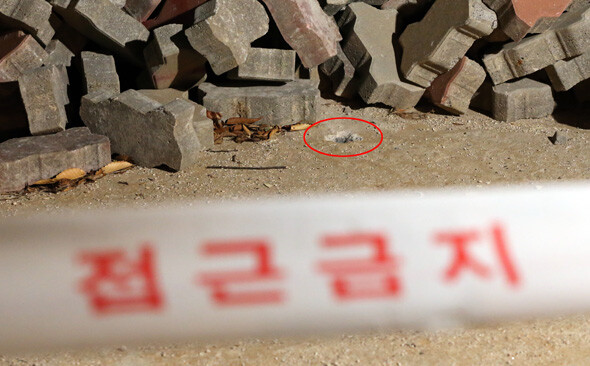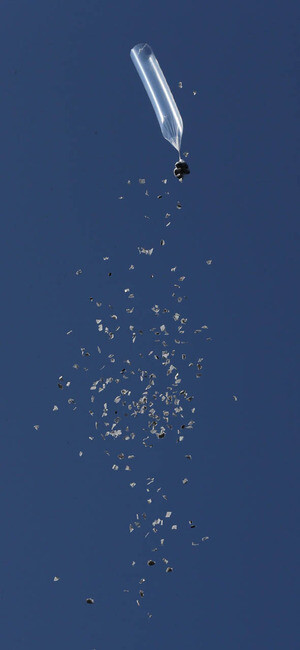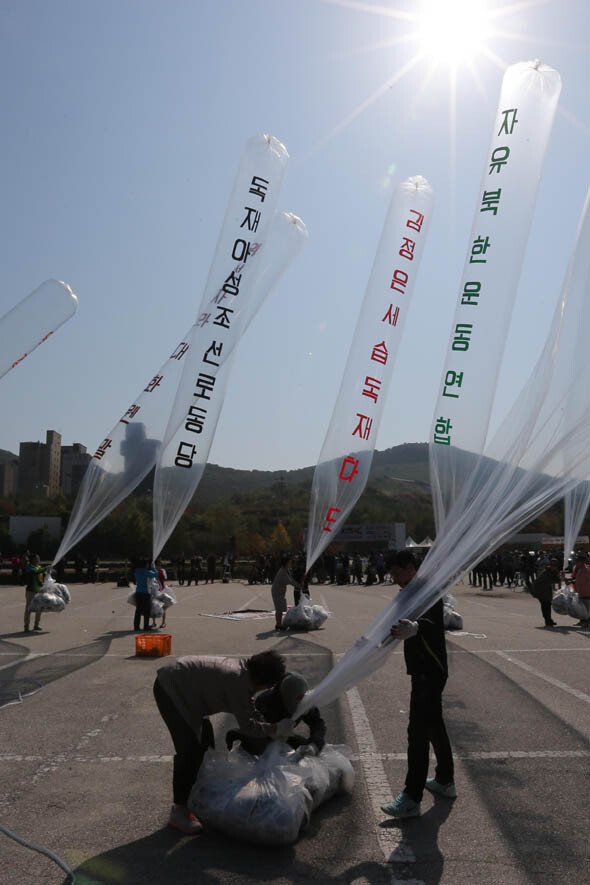hankyoreh
Links to other country sites 다른 나라 사이트 링크
[Anaysis] N. Korea shoots at activists’ propaganda balloons

By Choi Hyun-june, staff reporter
North Korea’s shooting down of balloons in Gyeonggi Province carrying leaflets from a South Korean group on Oct. 10 sent a strong message of warning from the military on the propaganda issue.
Experts agreed that such a move from North Korea could be seen as an ultra-hardline response on the issue, but is not expected to be enough to further hurt ties between Pyongyang and Seoul. Many experts recommended a measured response from both sides to keep alive the hard-won possibility for renewed dialogue.

An unnamed source with the Joint Chiefs of Staff explained the circumstances of the shootdown.
“Balloons carrying leaflets to North Korea were being launched from the Yeoncheon area by the Campaign for Helping North Korean in Direct Way [sic] and other private groups, when at around 3:55 pm our military began detecting around a dozen gunshots in the enemy region, lasting for a total of about ten minutes,” the source said on Oct. 10.
“At around 4:50, we discovered several rounds of cartridges from what are believed to be 14.5 mm anti-aircraft machine guns used by the North Korean military,” the source added. “They were found below the Civilian Control Line about 5 km from the Military Demarcation Line, near a South Korean military post and the Jung township office in Yeoncheon County, Gyeonggi Province.”
The intensity of North Korea’s response is a clear signal of how seriously it takes the leaflet issue. The Committee for the Peaceful Reunification of the Fatherland, its main organ for South Korea issues, sounded a note of dire warning when North Korean refugee groups first announced the sending of balloons on Oct. 9.
“If the South Choson [Korean] authorities permit or condone this leaflet distribution mayhem, North-South relations will once again hurtle toward irrecoverable catastrophe,” the committee cautioned.
A halt to the leaflets was also mentioned by Pyongyang on Sept. 13 as a precondition for inter-Korean dialogue, with references to “a strike at the source.”
“We do not conceal the fact that if the balloons launches resume, we are resolved to immediately incinerate the source of the provocation in the psychological campaign, as well as anyone supporting or directing it,” said a spokesman for North Korea’s delegation to the senior-level talks at the time.
The spokesperson also claimed that South Korean leaflet distributions had been “sharply increasing” since August.
“On some days, as many as 1.2 million leaflets and 2,250 pieces of subversive religious propaganda are being attached to balloons and flown into our territory,” the spokesperson said.
A North Korea expert, speaking on condition of anonymity, noted that the leaflets “often contain slanderous claims about Kim Jong-un, someone who is referred to in North Korea as ‘our supreme dignity.’”
“Given the nature of the North Korean regime, [the military] is responding so intensely because their loyalty might be questioned if they didn’t,” the expert explained.
The North Korean threat may be mounting, but if anything Seoul has been more sluggish in responding.
“The leaflets represent freedom of expression and a private area that we cannot regulate,” the Ministry of the Unification said of the distributions in mid-September. It’s a stance that Seoul has consistently maintained until recently, when three core officials from North Korea’s leadership came to the South to attend the closing ceremony for the Asian Games in Incheon, reached an agreement on Oct. 4 to hold a second round of high-level talks.
Since then, signs of change have been visible. When Park Sang-hak, president of the group Fighters for Free North Korea, announced plans on Oct. 9 to send more leaflets, the Ministry of Unification broke from previous practice by phoning him and trying to talk him out of it.
While the shootdown obviously isn’t good for inter-Korean relations, it’s also unlikely to have a lasting impact. To begin with, the shots were fired not at South Korean land or residents, but into the air at incoming balloons - a strong message of warning, but not a threat to lives or property.
Now Seoul could draw a clear line on the leaflet issue with South Korean groups, even as it sends a clear and powerful message of protest on the shootdown.
“It’s become clearer than ever that the leaflets are a real threat to inter-Korean relations,” said Kim Chang-soo, director of research at the Korea National Strategy Institute.
“They are obviously hurting the local economy, encouraging North Korean provocations, and reversing the progress made with inter-Korean agreements,” Kim added. “The Ministry of Unification needs to establish regulations to provide for punishments on this issue.”

Please direct questions or comments to [english@hani.co.kr]

Editorial・opinion
![[Guest essay] Amending the Constitution is Yoon’s key to leaving office in public’s good graces [Guest essay] Amending the Constitution is Yoon’s key to leaving office in public’s good graces](https://flexible.img.hani.co.kr/flexible/normal/500/300/imgdb/original/2024/0416/8917132552387962.jpg) [Guest essay] Amending the Constitution is Yoon’s key to leaving office in public’s good graces
[Guest essay] Amending the Constitution is Yoon’s key to leaving office in public’s good graces![[Editorial] 10 years on, lessons of Sewol tragedy must never be forgotten [Editorial] 10 years on, lessons of Sewol tragedy must never be forgotten](https://flexible.img.hani.co.kr/flexible/normal/500/300/imgdb/original/2024/0416/8317132536568958.jpg) [Editorial] 10 years on, lessons of Sewol tragedy must never be forgotten
[Editorial] 10 years on, lessons of Sewol tragedy must never be forgotten- [Column] A death blow to Korea’s prosecutor politics
- [Correspondent’s column] The US and the end of Japanese pacifism
- [Guest essay] How Korea turned its trainee doctors into monsters
- [Guest essay] As someone who helped forge Seoul-Moscow ties, their status today troubles me
- [Editorial] Koreans sent a loud and clear message to Yoon
- [Column] In Korea’s midterm elections, it’s time for accountability
- [Guest essay] At only 26, I’ve seen 4 wars in my home of Gaza
- [Column] Syngman Rhee’s bloody legacy in Jeju
Most viewed articles
- 1[Guest essay] Amending the Constitution is Yoon’s key to leaving office in public’s good graces
- 2[Editorial] 10 years on, lessons of Sewol tragedy must never be forgotten
- 3Faith in the power of memory: Why these teens carry yellow ribbons for Sewol
- 4Final search of Sewol hull complete, with 5 victims still missing
- 5[Guest essay] How Korea turned its trainee doctors into monsters
- 6How Samsung’s promises of cutting-edge tech won US semiconductor grants on par with TSMC
- 7Korea ranks among 10 countries going backward on coal power, report shows
- 8Pres. Park an accomplice in ordering resignation of CJ Group vice chairman
- 9[News analysis] Watershed augmentation of US-Japan alliance to put Korea’s diplomacy to the test
- 10K-pop a major contributor to boom in physical album sales worldwide, says IFPI analyst